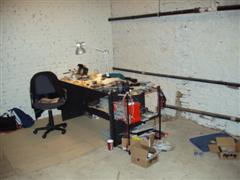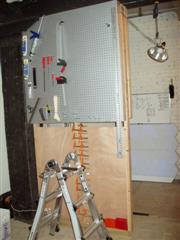Miscellaneous Progress
Test Module
Progress continues on the smaller test module that I mentioned in my previous post.
I've got the pixel divider walls and the backing glued together, and I tested using aluminum tape on the floor of the pixels. As it turns out, Home Depot stopped carrying the 2'x4' 1/8" white marker board, and now only carry a brown version of it. It's not nearly as glossy (plus, it's brown), so I'm attempting to use the aluminum tape as a reflective agent on the floor as well.
The small number of pixels, combined with the assembly method I have, actually makes this small one not very easy to keep "true", as far as the pixel shapes are concerned. There are only 2 triangles that end up being "perfect", and they're not adjacent to each other (only kissing), so everything kinda wobbled around a little, until I got the floor glued to it.
Soldering
I started into soldering up another driver board, mainly to get myself back into things. The only components I got soldered onto the board were 2 resistors and 2 capacitors. The tip I had used for the first time around is basically useless for the very small-pitch components. It's gotten so built up with debris, and has probably had the tip melted or broken off, so it's not nearly as fine as I need it to be. I'll need to order about 5 of those bad-boys to keep me in stock.
Design
I just got a new tablet PC on Thursday and finally got that up and running. I got all of my development tools installed, brought the tablet over to the work space, and hooked it up to the processor to make sure everything works. It still does, thankfully, and having a small portable communication medium for programming it will be a great help. I also put the visualization Python code on it and tested it out for performance. It runs at about 1/2-1/3 the speed as my desktop, peaking at about 25ms per frame at the highest resolution, so I think it should be fine for "production" use.
I need to start writing more with that code, so other people can start playing around with it. It's pretty rudimentary right now, but I hope to get it to the point where patterns, shapes, text, etc. can be made as individual files and then loaded on the fly.
Media
OK, so you gotta start out small, I guess. I was contacted by one of the writer/director/producers of an up-coming short show called Center Earth about using the technowall as part of background for various scenes. Shooting is slated to start in mid April, and the wall will probably be needed some time in May-ish. There's not much more to say about it yet, but I'll keep everyone posted about progress with it.
Labels: Construction, Design, Media, Soldering



